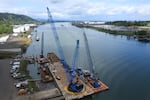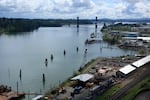
Hundreds of parties share responsibility for cleaning up the Portland Harbor Superfund Site.
Cassandra Profita/OPB
Four of the parties responsible for cleaning up the polluted Portland Harbor say new testing shows the Superfund cleanup plan should be scaled back.
But the U.S. Environmental Protection Agency disagrees.
Arkema Inc., Evraz Inc., Schnitzer Steel and The Marine Group have spent about $12 million testing the river's water, sediment and fish for contamination over the past two years in cooperation with the EPA.
The idea was to provide an updated look at the extent of pollution along the 11-mile Superfund site to guide the next phase of the cleanup process, in which hundreds of parties that share responsibility for cleaning up the area hash out their own individual clean-up plans.
The Willamette River's Portland Harbor Superfund site runs north from the Broadway Bridge to Columbia Slough. It's highly contaminated with dozens of pollutants from more than a century of industrial use. The EPA has spent decades developing a $1 billion cleanup plan.
As part of that plan, the four companies agreed to map the bottom of the river, collect hundreds of soil and water samples and test them for pollution, and track and test resident fish for contaminants.
These companies say their latest testing shows the river is much cleaner than it was in 2004 — the last time the area was comprehensively sampled. In a report to the EPA, the group argues its findings support significant changes to the federal clean-up plan and major reductions in the amount of acreage that will need active cleanup.

The Portland Harbor Superfund Site, a highly polluted 10-mile stretch of the Willamette River, in 2019.
Cassandra Profita/OPB / OPB
“The site has recovered significantly,” the report states. “Concentrations of contaminants of concern have significantly decreased in site sediment, surface water and fish tissue, greatly reducing the risks associated with the site.”
The EPA’s plan includes removing contamination in the river through dredging or covering it up by capping it with clean soil. But the companies say their test results support reducing the amount of dredging required by 75% and increasing the area left to recover naturally — without any active clean-up work — from 84% in the EPA’s existing plan to about 95%.
Documents show the new pollution testing found levels of the toxic industrial pollutants PCBs (polychlorinated biphenyls) have dropped by 52% across the Superfund site since 2004 while levels of PAHs (polycyclic aromatic hydrocarbons) dropped 79%.
The EPA ordered, approved and supervised the testing, and the agency says the results are acceptable. However, in a memo and comments responding to the group's report, the EPA made it clear that it does not support the group's conclusions about scaling back its cleanup plan.
“In general, the EPA does not agree that the data collected or the Pre-RD Group’s analysis support many of the conclusions presented,” Davis Zhen wrote in a Sept. 13 letter. “However, these new data sets … will form the key underlying support for decision-making as remedial design work proceeds.”

Travis Williams, executive director of Willamette Riverkeeper, holds sand from the banks of the Willamette River in the Portland Harbor.
Allison Frost / OPB
Travis Williams with the environmental group Willamette Riverkeeper said the EPA's existing plan already allows for a lot of natural recovery and only requires dredging and capping on 16% of the site.
"One of the things that group is trying to advocate for is doing even less cleanup of the river bottom," he said. "I think it’s good [the] EPA is pushing back on that and saying, 'No we disagree with you.' For us and many others who have been working on this it’s a pretty disappointing presentation by some of these companies."
EPA documents indicate the new pollution testing results will be used to update cleanup plans, but officials are still working to move the cleanup forward without delays. The agency has sent numerous letters to parties involved in the cleanup asking them to submit individual cleanup plans. So far, only a handful of parties have taken that step.
An industry representative familiar with the report from the four parties that did the recent pollution testing says the companies will eventually have to decide whether to challenge the EPA in court.
He spoke with OPB on the condition of anonymity to protect his client’s position in the confidential allocation process, a closed-door proceeding where hundreds of companies are working out who is going to pay for how much of the cleanup.
“It makes sense to adjust the cleanup based on what the river looks like today,” he said. “We volunteered to do this. We spent $12 million and 18 months. We have a robust data set that shows the river getting cleaner. The EPA approved the research and won’t use the data.”
He said dozens of other parties are ready to move forward with their cleanups using the new data, and they’re hoping the Trump administration will reconsider the agency’s position.
“It’s just a shame that we’ve wasted all this time and effort to compile the most comprehensive view of the river in more than a decade and EPA staff don’t want to use that information to tailor the scope and size of the cleanup,” he said. “At a time when the administration is reversing all the major Obama-era EPA decisions from greenhouse gas requirements to wetlands regulations, to double down on backing the last-minute Obama administration cleanup decision on Portland Harbor makes no sense.”
EPA officials declined to speak on the record with OPB about the new pollution testing. But in detailed comments written in response to the companies' report on the testing results, the agency suggests that the group draws conclusions that challenge key underpinnings of the 2017 cleanup plan for the site, including studies that took decades to complete and would likely take many more years to revise.
A representative of another party involved in the allocation process said a lot of companies are ready to be done paying for the ongoing expenses involved in the cleanup. He declined to be named because the allocation process is confidential, but he said dozens of parties are weighing whether or not they should move forward with their plans or hold off because of the new pollution testing results.
He said some parties are at risk of running out of insurance money and declaring bankruptcy before the cleanup is through.
“There are a lot of companies paying for environmental consultants, government relations consultants, public relations consultants - it’s extraordinarily expensive - and it’s not something most companies want to have on their books long-term,” he said. “For our company, we’d like to move forward, pay our fair share of the cleanup and return the river back to the people of Portland.”
